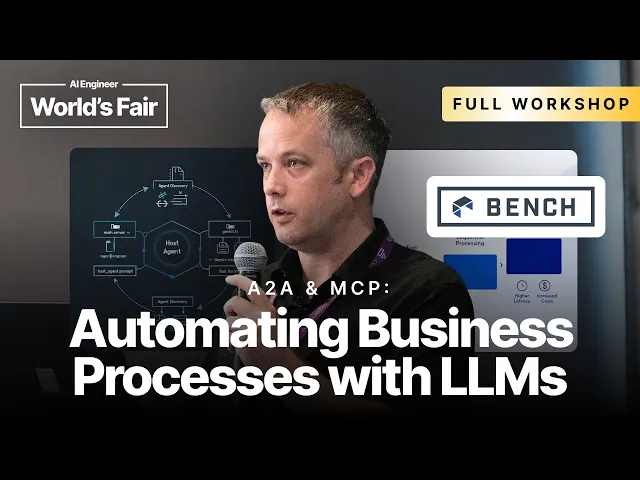A2A & MCP Workshop: Automating Business Processes with LLMs

AI business automation you can start today
In the rapid evolution of enterprise AI, many leaders find themselves overwhelmed by the complexities of implementation. Damien Murphy's presentation at the A2A & MCP Workshop cuts through this confusion, offering a pragmatic blueprint for automating business processes with large language models (LLMs). As someone who has observed countless organizations struggle with AI adoption, I found Murphy's approach refreshingly actionable—focusing not on theoretical possibilities but on practical applications that deliver measurable value today.
Murphy's insights come from real-world experience at Bench, where they've successfully deployed AI to transform accounting workflows. What stands out isn't just the technology itself, but the thoughtful methodology behind identifying and prioritizing automation opportunities. For business leaders seeking tangible returns on AI investments, this presentation offers a valuable roadmap that avoids both technical rabbit holes and unrealistic expectations.
Key points from Murphy's approach:
-
Start with process mapping rather than technology selection. By identifying and documenting workflows first, organizations can pinpoint high-value automation opportunities that align with business objectives.
-
Focus on "drudgery elimination" as the initial target for AI implementation. Tasks requiring mechanical transformation of information—like data extraction and classification—offer immediate ROI while building organizational confidence.
-
Adopt a "human in the loop" framework that leverages AI for what it does best while maintaining human oversight. This pragmatic approach balances efficiency gains with quality control.
-
Implement iterative testing cycles to continuously refine AI systems. Starting with a small set of transactions and progressively expanding scope allows for controlled scaling while managing risks.
Why process-first AI adoption matters
The most compelling insight from Murphy's presentation is his emphasis on process-first implementation. While many organizations rush to adopt the latest AI technology without clear use cases, Murphy demonstrates how starting with thorough process mapping leads to significantly better outcomes. This approach ensures AI investments directly address business pain points rather than becoming solutions in search of problems.
This perspective aligns with broader industry trends showing that successful AI implementations typically begin with comprehensive process analysis. According to McKinsey, companies that conduct detailed workflow mapping before AI deployment are 2.3 times more likely to achieve positive ROI on their projects. In an era where 87% of AI initiatives fail to deliver expected value, Murphy's methodical
Recent Videos
How To Earn MONEY With Images (No Bullsh*t)
Smart earnings from your image collection In today's digital economy, passive income streams have become increasingly accessible to creators with various skill sets. A recent YouTube video cuts through the hype to explore legitimate ways photographers, designers, and even casual smartphone users can monetize their image collections. The strategies outlined don't rely on unrealistic promises or complicated schemes—instead, they focus on established marketplaces with proven revenue potential for image creators. Key Points Stock photography platforms like Shutterstock, Adobe Stock, and Getty Images remain viable income sources when you understand their specific requirements and optimize your submissions accordingly. Specialized marketplaces focusing...
Oct 3, 2025New SHAPE SHIFTING AI Robot Is Freaking People Out
Liquid robots will change everything In the quiet labs of Carnegie Mellon University, scientists have created something that feels plucked from science fiction—a magnetic slime robot that can transform between liquid and solid states, slipping through tight spaces before reassembling on the other side. This technology, showcased in a recent YouTube video, represents a significant leap beyond traditional robotics into a realm where machines mimic not just animal movements, but their fundamental physical properties. While the internet might be buzzing with dystopian concerns about "shape-shifting terminators," the reality offers far more promising applications that could revolutionize medicine, rescue operations, and...
Oct 3, 2025How To Do Homeless AI Tiktok Trend (Tiktok Homeless AI Tutorial)
AI homeless trend raises ethical concerns In an era where social media trends evolve faster than we can comprehend them, TikTok's "homeless AI" trend has sparked both creative engagement and serious ethical questions. The trend, which involves using AI to transform ordinary photos into images depicting homelessness, has rapidly gained traction across the platform, with creators eagerly jumping on board to showcase their digital transformations. While the technical process is relatively straightforward, the implications of digitally "becoming homeless" for entertainment deserve careful consideration. The video tutorial provides a step-by-step guide on creating these AI-generated images, explaining how users can transform...
